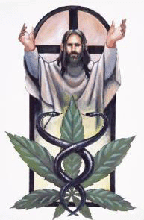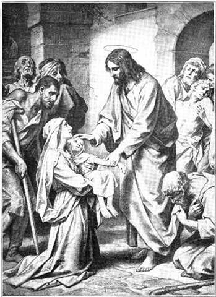Was there a whiff of cannabis about Jesus?
Claims
of drug use by biblical figures surprisingly have susbtance,
says Professor Carl Ruck
 Was Jesus a Stoner? is the mischievous title
of an article about the use of cannabis in ancient Judaism in next
month’s High Times, a pro-cannabis magazine. Its author,
Chris Bennett, likes to shock. He is the host of Burning Shiva, a show
on Canada’s Pot-TV, and an advocate for the medical use and
decriminalisation of marijuana.
Was Jesus a Stoner? is the mischievous title
of an article about the use of cannabis in ancient Judaism in next
month’s High Times, a pro-cannabis magazine. Its author,
Chris Bennett, likes to shock. He is the host of Burning Shiva, a show
on Canada’s Pot-TV, and an advocate for the medical use and
decriminalisation of marijuana.
Bennett first looked at the use of drugs in religion two years ago in his book Sex, Drugs, Violence, and the Bible. He postulates that Jesus’s ministry was fuelled by mind-altering substances, that he may have used cannabis-based oils to heal eye and skin diseases and that his very name – Christ – derives from being anointed with cannabis-enriched oil.
His politics and television career might make it tempting to dismiss him but what Bennett says makes perfect sense. Over the centuries drugs have been used by virtually all religions. Why not Christianity?
In ancient times cannabis was widely cultivated throughout the Middle East. It grows like a weed and provides nourishing seed, which is also a good source of fibre used to make rope.
People certainly knew of its pleasurable effects; it would have been impossible to harvest it without becoming ecstatic as the drug would be absorbed through the skin. And as long ago as 1935 a Slovakian linguist identified the plant known as “fragrant cane” in the English Bible as flowering cannabis, a link since accepted by some Jewish authorities.
Ancient people were fascinated by herbs and their healing powers and knew much more about them than we do; at least about mixing herbs to release their potency.
Ancient wines were
always fortified, like the “strong wine” of the Old Testament, with
herbal additives: opium, datura, belladonna, mandrake and henbane.
Common incenses, such as myrrh, ambergris and frankincense are
psychotropic; the easy availability and long tradition of cannabis use
would have seen it included in the mixtures. Modern medicine has looked
into using cannabis as a pain reliever and in treating multiple
sclerosis. It may well be that ancient people knew, or believed, that
cannabis had healing power. 
Entheogen comes from the Greek entheos (meaning “god-inspired within”) and the word is now commonly employed in English and European languages to discuss sacramental foods used by shamans (mystic or visionary priests) to achieve spiritual ecstasy.
So what of the early Christians? At the time they were evolving, they had to compete with other religions of the Roman empire. The strongest of those was Mithraism, imported from Persia, which exists today as Zoroastrianism.
Its sacrament, Haoma, was virtually identical to what we know of soma, in Brahmanism. Worshipped as a god, soma was a strange plant without leaves or roots that needed little light and induced religious ecstasy. It was most likely amanita muscaria: a magic mushroom. In ancient Rome sharing the Haoma cemented the bond of brotherhood of emperors, bureaucrats and soldiers. Pagan Greek celebrations at the sanctuary of Eleusis, meanwhile, included a visionary experience for a crowd of 1,000 people, from drinking a potion made from a fungus that grows on wheat and produces an effect similar to LSD.
So, did Jesus use cannabis? I think so. The word Christ does mean “the anointed one” and Bennett contends that Christ was anointed with chrism, a cannabis-based oil, that caused his spiritual visions. The ancient recipe for this oil, recorded in Exodus, included over 9lb of flowering cannabis tops (known as kaneh-bosem in Hebrew), extracted into a hin (about 11 pints) of olive oil, with a variety of other herbs and spices. The mixture was used in anointing and fumigations that, significantly, allowed the priests and prophets to see and speak with Yahweh.
Residues of cannabis, moreover, have been detected in vessels from Judea and Egypt in a context indicating its medicinal, as well as visionary, use. Jesus is described by the apostle Mark as casting out demons and healing by the use of this holy chrism. Earlier, from the time of Moses until the later prophet Samuel, holy anointing oil was used by the shamanic Levite priesthood to receive the “revelations of the Lord”. The chosen ones were drenched in this potent cannabis oil.
Early Christian documents found in Eygpt, thought to be a more accurate record than the New Testament, portray Jesus as an ecstatic rebel sage who preached enlightenment through rituals involving magical plants. Indeed, Bennett goes so far as to say that Jesus was probably not born the messiah but acquired the title when he was anointed with cannabis oil by John the Baptist. The baptism in the Jordan was probably to wash away the oil after it had done its work. The early Christians fought hard for followers in the ancient world, recognising the similarity of their own “foreign” god and his eucharistic meal to the Greek gods. Various sects and even the elite in what would eventually become the Roman Catholic church probably used the full range of available entheogens for baptism, ordination and the eucharistic meal.
What we now call the host might have been more than just bread. There are indications that early Christians shared magic mushrooms – and the spiritual visions and ecstasies they occasioned – as their eucharistic meal. A 4th-century mosaic discovered at a basilica in Aquileia in northern Italy depicts baskets of mushrooms. Why? This wasn’t a restaurant. Could the “red mushrooms” have been the ritual meal?
Eating bread and sharing wine together was, and remains, at the heart of the Christian ritual. We’ll never know exactly what Jesus and his disciples consumed at the Last Supper, but as they believed they were drinking the blood of Christ we must accept it was – if not actually hallucinatory – at least fortified by God.
Carl Ruck is professor of classics at Boston University